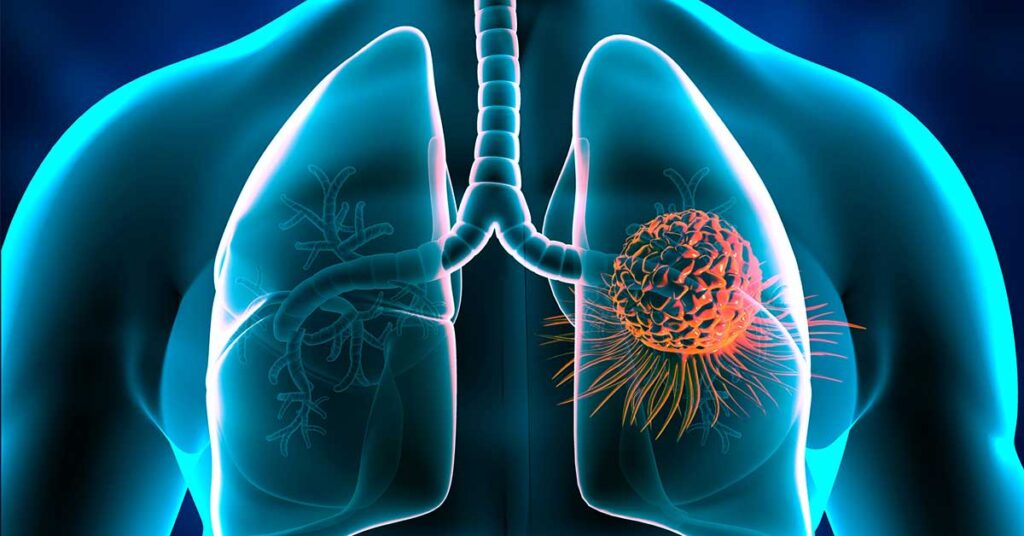Lung Cancer Treatment
Lung cancer treatment depends on several factors, including the symptoms presented, as well as the type and stage of the.
Learn more about lung cancer and lung cancer in Singapore – what it is, its types, symptoms, risk factors, and tests for diagnosis.
Table of Contents
ToggleLung cancer is the third most frequent incident cancer diagnosed in men and women in Singapore from 2017 to 2021.

Lung Cancer
Lung cancer starts when abnormal cells grow and multiply in an uncontrolled way. Lung cancer begins in the lungs and may spread to lymph nodes or other organs in the body. If cancer begins in another part of the body and spreads to the lungs it is known as secondary or metastatic cancer in the lung.
Lung cancers are usually grouped into two main types: small cell lung cancer (SCLC) and non-small cell lung cancer (NSCLC). This is diagnosed based on how the cells look under a microscope.
NSCLC is the more common type of lung cancer, comprising approximately 85% of lung cancers. It is less aggressive and spread less quickly than SCLC. If discovered early, surgery and/or radiation therapy, or chemotherapy may be used as treatment.
There are sub-types of non-small cell lung cancer. The most common are:
SCLC is fast-growing, aggressive, and rapidly spreads through the bloodstream and lymphatics to other parts of the body. Though not as common, it is often advanced at diagnosis. It is usually treated with chemotherapy alone or in combination with radiotherapy.
Along with the main types of lung cancer, other tumours can occur in the lungs.
Lung cancer has the highest mortality rate among cancers for males in Singapore and the third highest among women living in Singapore, respectively. According to the Singapore Cancer Registry’s 2021 report, lung cancer accounted for 24.8% of cancer deaths in males and 14.9% of cancer deaths in females in Singapore between 2017 – 2021.
Although in Singapore lung cancer has poor survival rates, the silver lining is that lung cancer can be treated. Moreover, lung cancer treatments are continuously being improved.
Lung cancer does not always produce noticeable symptoms in the early stages. Because there are very few nerve endings in the lungs, a tumour could grow without causing pain or discomfort. As a result, many people are not diagnosed until the disease has advanced. However, there are a few early symptoms that do occur in some people. When symptoms are present, they may also present differently in each person.
When lung cancer metastasizes (i.e., grows and spreads) to other parts of the body, it can result in symptoms that appear in those areas as well.
Medical experts recommend lung cancer screening with low-dose computed tomography (LDCT) for adults who are:
Diagnosing lung cancer starts with a check-up with a lung specialist and a physical exam. They’ll want to go over your medical and family history and any symptoms you’re having. You will also need blood tests, scans and/or biopsies to confirm the diagnosis. The tests may include:
If you have a cough and currently produce sputum, looking at the sputum under the microscope can sometimes reveal the presence of lung cancer cells.
A sample of abnormal cells may be removed in a procedure called a biopsy.
Your doctor can perform a biopsy in several ways, including bronchoscopy, in which your doctor examines abnormal areas of your lungs using a lighted tube that’s passed down your throat and into your lungs.
In this procedure, the doctor aims to take tissue samples from the lymph nodes. This is done through an incision at the base of the neck followed by using surgical tools to take the tissue samples.
Careful analysis of your cancer cells in a lab will reveal what type of lung cancer you have. Results of sophisticated testing can tell your doctor the specific characteristics of your cells that can help determine your prognosis and guide your treatment.
It is advisable to consult your doctor or see a lung specialist if you notice symptoms of lung cancer. These lung specialists can also recommend strategies for quitting smoking, such as counselling, medications, and nicotine replacement products to those who are planning on quitting smoking or are unable to give up the habit of smoking.
Health365, in partnership with trusted medical providers in Singapore, Malaysia, and Thailand offers booking for lung cancer diagnostic tests.
Lung cancer treatment depends on several factors, including the symptoms presented, as well as the type and stage of the.
In this article we explore the risk factors for lung cancer - one of the top cancers in Singapore.
Lung cancer is one of the top cancers for males and females in Singapore. Here are the signs and symptoms.
We explain the various stages of lung cancer in this article.
From 2015 to 2019, Lung cancer was the third most common cancer among males and females residing in Singapore. What are the.
Lung cancer is one of the top killer diseases in Singapore. Arm yourself with more information about lung cancer in.